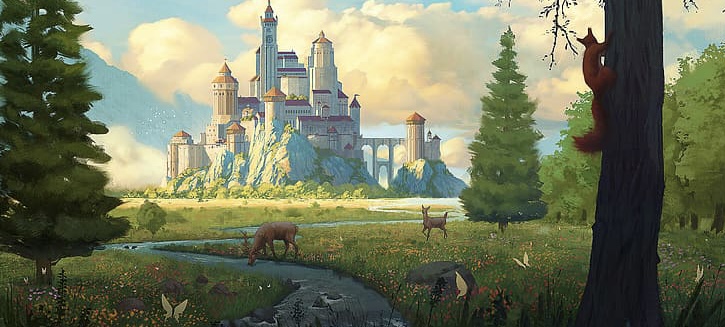Prenablus
The furthest reaches of Aressi civilization. This province is nestled between mountains, the sea, and the scorched plains of intoncuilado.
Structure
- Count: Head of the royal family and the country.
- Viscount: Leader of a shire and blood relative to the count. They manage large towns and agrarian estates.
- Thane: Head of a lesser noble family, serves the viscounts or count directly as administrators of fiefs of their land.
- Mayor: Cities have a city council, led by a mayor. The councilors are aristocrats, but not gentry.
- Landman: Member of the gentry, holds office at various levels of government.
Public Agenda
To protect and maintain its citizens and holdings. Pave, repair, and secure roads. Dig wells and sewage/ drainage ditches. Provide security from bandits and invasion. Build, maintain, and secure bridges and ports. Provide courts for high and low justice. Maintain birth/ death records and citizen rolls. Enforce construction standards on homes. Mint coins and catch counterfeiters. Ensure doctors and priests make their rounds. Ensure skilled labor jobs are filled (carpenter, smith, weaver, glazer, etc.) Guard against disasters such as famine, fire, flood, and disease. Provide a mill, either wind or water. Provide grounds and security for fairs.
Territories
The river Prenadi runs through the middle of this county, with two major tributaries leading into it. The lands occupied by the province amount to these rivers, everything within 100 miles of its banks on either side, and down the coast to the swamp leading to Faraus Ofim Catior.
Religion
Strong adherents to the Church of the Great Mother, most of the Oath Keepers come from these lands. The keepers of the oath focus on causes of righteousness and justice. They maintain a vigilant eye on the world of man and seek to stop any evil before it can even arise. Their network of eyes and ears is unmatched in the land. It is mostly these priests who attend this segment of the flock.
Agriculture & Industry
Great farming estates produce rice, maize, barley, and various other grains. Brown and white beans, lettuce, spinach, kale, yams, potatoes, melons, citrus fruit, and more feed this region and the neighboring ones. Flax made linens are popular and produced at large scale.
Trade & Transport
Trade routes follow the river southeast and go by land northwest. River ships capable of carrying several tons make their way down river, while wagon trains make the return trip as merchants take their goods to market. Once at the mouth of the river at the Sostaut Sea a merchant can continue on ship along the coast. To go out to the many islands of the sea a different ship is required. Land routes exist to go south and west, but none lead north into the badlands.
Education
The quality of education varies from city to town, but in all areas, students are learning at the age of 7. This is true for both boys and girls. The gentry send their children to the noble courts and the poor mostly rely on the church. They teach academics weekday mornings and religious studies on the weekend, after mass. Until the age of 14 they learn the basics of language and etiquette.
At age 14 some students begin the studies of higher learning, starting with the liberal arts and followed by the practical arts. Several major cities have universities, and the monastery offers a similar program. Firstly, they learn the trivium of grammar, logic, and rhetoric. Then they learn the quadrivium of arithmetic, geometry, harmonics, and astronomy. The practical arts are only taught in specific academies. Law, medicine, and war are taught at universities in the capital. And every major city and town has guilds regulating certain industries. The most common and most powerful are flax farmers, taylors, weavers, and chaloners. Every profession can be governed by the guilds if there are enough of them in an area. One can begin their formal training with nothing more than a formal education in language and etiquette.
The creative arts are taught by masters on a one-on-one basis, these studies are reserved for those with a wealthy parent or patron. The poor can be taken in by a master if they have great talent but will be working for free until they pay off that debt. The leading fields are painted walls, pillars, and statues, epic poems and ballads, and carved pots and tools. The younger one starts, the better. The performing arts are taught by masters in a classroom setting, these studies are most commonly left to the common man. Anyone who can afford the fees are welcome. Juggling, acrobatics, and the like are the highest forms of the art. Acting, singing, and playing instruments are viewed as lesser and require less of a financial commitment to learn.
Infrastructure
This province has hard packed dirt roads crossing its entirety to facilitate the movement and trade between cities. Walled cities with protected docks dot the rivers and remote forts protect the frontier. There are several wooden bridges and shallow fords operated by the county to protect river crossings, water mills along the river, wells in towns too far from the shore and drainage ditches to dispose of the water after. The courts exist for both high and low justice, to maintain birth and death records, mint coinage and catch counterfeiters, and provide safe fairgrounds.
Type
Geopolitical, County / March
Demonym
Prenablan
Government System
Monarchy, Crowned Republic
Power Structure
Feudal state
Economic System
Palace economy
Currency
The Femun is the official coinage of this county and can be steel, copper, silver, or gold. There are four denominations regardless of material: the yafemun (1), lifemun (2), clearfemun (3), and cofemun (4).
Official State Religion
Official Languages
Related Traditions
Neighboring Nations
Related Species



Comments